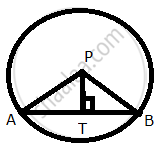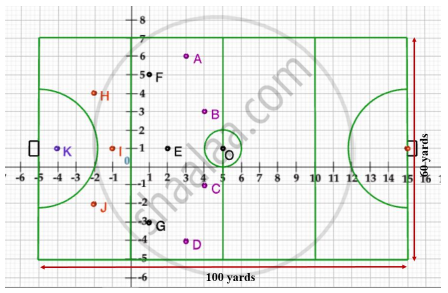Advertisements
Advertisements
Question
The point which lies on the perpendicular bisector of the line segment joining the points A(–2, –5) and B(2, 5) is ______.
Options
(0, 0)
(0, 2)
(2, 0)
(–2, 0)
Solution
The point which lies on the perpendicular bisector of the line segment joining the points A(–2, –5) and B(2, 5) is (0, 0).
Explanation:
We know that, the perpendicular bisector of the any line segment divides the segment into two equal parts i.e., the perpendicular bisector of the line segment always passes through the mid-point of the line segment.
Mid-point of the line segment joining the points A(–2, –5) and B(2, 5)
= `((-2 + 2)/2, (-5 + 5)/2)` ...`["Since, mid-point of any line segment which passes through the points" (x_1, y_1) "and" (x_2, y_2) = ((x_1 + x_2)/2, (y_1 + y_2)/2)]`
= (0, 0)
Hence, (0, 0) is the required point lies on the perpendicular bisector of the lines segment.
APPEARS IN
RELATED QUESTIONS
Prove that the points A(1, 7), B (4, 2), C(−1, −1) D (−4, 4) are the vertices of a square.
The long and short hands of a clock are 6 cm and 4 cm long respectively. Find the sum of the distances travelled by their tips in 24 hours. (Use π = 3.14) ?
Find the distances between the following point.
R(–3a, a), S(a, –2a)
Find the distance between the following pairs of point in the coordinate plane :
(13 , 7) and (4 , -5)
Prove that the points (1 ,1),(-4 , 4) and (4 , 6) are the certices of an isosceles triangle.
Find the distance between the following pairs of points:
`(3/5,2) and (-(1)/(5),1(2)/(5))`
Point P (2, -7) is the centre of a circle with radius 13 unit, PT is perpendicular to chord AB and T = (-2, -4); calculate the length of AB.

Find distance between point A(–1, 1) and point B(5, –7):
Solution: Suppose A(x1, y1) and B(x2, y2)
x1 = –1, y1 = 1 and x2 = 5, y2 = – 7
Using distance formula,
d(A, B) = `sqrt((x_2 - x_1)^2 + (y_2 - y_1)^2`
∴ d(A, B) = `sqrt(square +[(-7) + square]^2`
∴ d(A, B) = `sqrt(square)`
∴ d(A, B) = `square`
If the distance between the points (x, -1) and (3, 2) is 5, then the value of x is ______.
Case Study -2
A hockey field is the playing surface for the game of hockey. Historically, the game was played on natural turf (grass) but nowadays it is predominantly played on an artificial turf.
It is rectangular in shape - 100 yards by 60 yards. Goals consist of two upright posts placed equidistant from the centre of the backline, joined at the top by a horizontal crossbar. The inner edges of the posts must be 3.66 metres (4 yards) apart, and the lower edge of the crossbar must be 2.14 metres (7 feet) above the ground.
Each team plays with 11 players on the field during the game including the goalie. Positions you might play include -
- Forward: As shown by players A, B, C and D.
- Midfielders: As shown by players E, F and G.
- Fullbacks: As shown by players H, I and J.
- Goalie: As shown by player K.
Using the picture of a hockey field below, answer the questions that follow:

What are the coordinates of the position of a player Q such that his distance from K is twice his distance from E and K, Q and E are collinear?
